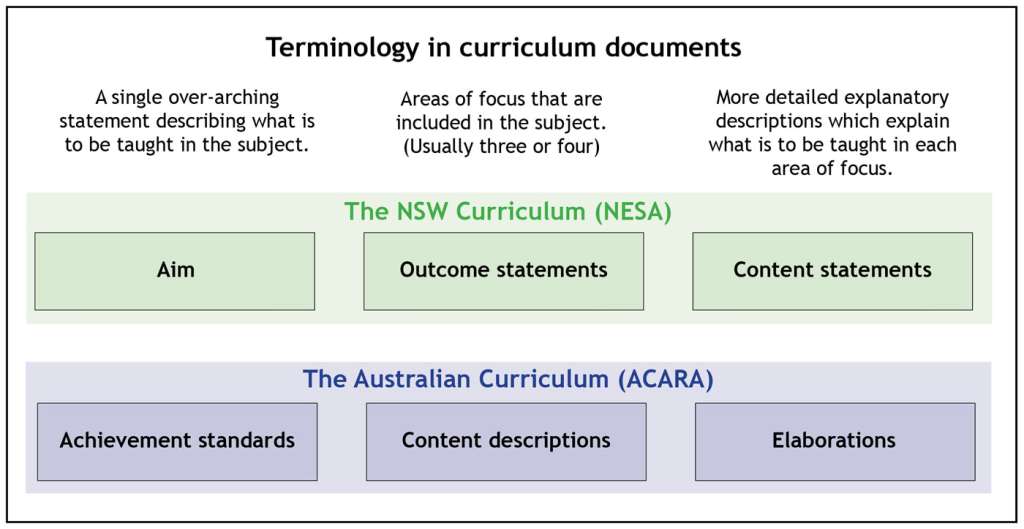
NSW Curriculum Changes for K-6 Music
A guideline to the changes in the NSW Creative Arts Curriculum for anyone teaching K-6 Music.
The New South Wales Creative Arts Syllabus is changing. NESA (The NSW Education Standards Authority) have announced changes this year to the Creative Arts Syllabus that has been in place since 2006.
NESA have introduced a new syllabus (2024) that is to be implemented from 2027.
Some secondary school music teachers are quite upset about the changes to their curriculum, and there has been quite a bit of attention in the media about these changes.
However this article is not about changes to the year 11-12 Curriculum, or even the grade 7-10 curriculum.
Here at the Fun Music Company, we specialize in K-6 Music, and so this article focuses on the changes that specifically affect anyone teaching K-6 Music in New South Wales. We will also highlight changes we are making to our programs to match the requirements, so that our programs are ready for teaching the new program in 2027.
The focus of this article is therefore to highlight the changes between the Creative Arts Syllabus (2006) and the Creative Arts Syllabus (2024), particularly relating to MUSIC.
Terminology differences between the Australian Curriculum and the NSW Curriculum
Governments don’t like to make it easy for us as teachers. If they did, they would at least use the same terminology in curriculum documents!
Every curriculum has a broad description for the subject, then 3-4 broad areas of focus, and then explanatory points underneath those areas of focus.
Confusion comes however, because the NSW Education Standards Authority (NESA) and the Australian Curriculum Assessment and Reporting Authority (ARACA) have different terminology for these aspects of the curriculum.
Before starting this article, we thought it was important to highlight this, as it may become confusion because the term “content” is used differently in the NSW Curriculum from how it is used in the Australian National Curriculum.
In an attempt to clarify the terminology difference between the Australian Curriculum and the NSW Syllabus documents, we came up with this diagram:

Where it is a little confusing is whether the content statements are mandatory in the NSW Curriculum. i.e. Is it actually required that teachers cover every single one of the content statements?
In the Australian Curriculum it is clear. It says here:
The content descriptions are accompanied by content elaborations, which are optional, and are provided to give teachers ideas about how they might teach the content.
So in the Australian National Curriculum, it is clear that it is NOT mandatory to cover every single elaboration.
The NSW Curriculum however, includes various statements on the word ‘content’ on this page and it is not clear reading this syllabus whether teachers must cover every single content statement or not.
Our reading of this seems to suggest that NESA regard their content statements as essential content, and therefore must be covered.
It says:
New syllabuses focus on essential content, which identifies the core skills and knowledge necessary for developing teaching and learning programs.
Essential content:
stands alone without the need for further elaboration, and can be easily sequenced
is necessary for students to progress in their learning
is part of students’ learning entitlement – the knowledge and skills that every student should have an opportunity to learn.
The good news is however, here at the Fun Music Company we have firmly ‘ticked the box’ on 80 of the 86 content statements included in the NSW Curriculum (2024) for K-6 Music and the last six will be fully covered by the time 2027 arrives.
An overview of the changes in the 2024 NSW Curriculum for K-6 Music
Here is an outline of the changes we have noticed, and then we’ll discuss each change in detail.
- 1
There is a change in name of one of the three focus areas of the curriculum from Organising Sound to Composing.
- 2There is one less outcome statement for Early Stage 1. Composing and Performing are joined together.
- 3Removal of the second outcome statement relating to notation in the Composing area in stages 1, 2 and 3. Now covered in content statements under the main outcome statement relating to composition.
- 4A new outcome statement added for Stage 3 relating to creating written texts supporting understanding in Music.
- 5
More content statements under each outcome statement. Previously there was 3-5 for each outcome statement, now there is 8-10.
- 6
Aboriginal and Torres Strait islander music is specifically mentioned in the listening and composing area content statements, but not the outcome statements.
Lets look in detail …
Now that we have an understanding of the broad changes, lets dig into each one of them in detail.

The more things change … the more they stay the same!
Looking through the NSW Creative Arts syllabus for K-6, it is clear to us that while many things have changed, the essential factors that make up the subject of MUSIC for us, have not changed.
Fundamentally the music part of the creative arts syllabus is focused around three core areas:
Performing,
Listening,
and
Composing.
Previously in the 2006 syllabus, there was performing, listening and organising sound. However, in the new version that has been renamed to composing, as fundamentally that is what it is.
So the fact that the three areas of focus have not changed is a very good thing. I don’t think there would be a music education professional anywhere that would have a problem with these three areas as the core focus of the curriculum.
The renaming from organising sound to composing, is essentially a very good thing. “Composing” is a word generally understood by the community, and in our understanding means the same as “organising Sound” but can be used more widely and more musically.

Kindergarten Students Perform and Compose Together?
In the NSW Creative Arts Curriculum (2006) There are outcome statements for Performing, “Organising Sound” (composing), and for Listening.
However in this new edition there are only two: Performing and Composing in one outcome statement, and Listening in a second.
This new combined statement reads:
“Performing and composing: Music is performed and made by organising sound through singing, moving and playing”
Exactly WHY this change has been made remains a mystery to us. No amount of searching on Google has explained the rationale for this change. Most likely it is simply to fit into a template or framework that is used in other subjects. Usually this is the reason for those type of changes.
However, the good news is that the content is the same as it was. Early Stage 1 students can still perform. They can still learn songs and chants. They can still learn to keep steady beat. They can still learn to clap, move, and play instruments in time. They can still compose.
If the same amount of lesson time is allocated, then it should still be allocated to Performing, Composing and Listening, exactly as it is for all other grades.
This change really doesn’t change anything in the way we need to teach music. We should teach it the same we always have, covering performing, composing and listening at Early Stage 1 as well as the other levels.

Less focus on notation doesn’t mean ‘dumbing’ anything down!
In the Composing area (previously called “Organising Sound”) there used to be a separate outcome statement in stages 1, 2 and 3 that specifically covered the use of symbol systems and traditional and non-traditional notation.
For example, stage 1 had MUS1.3 Uses symbol systems to represent sounds, and stage 2 had MUS2.3 Uses commonly understood symbols to represent own work.
In the new syllabus these have been removed.
Instead, the same things are covered in content statements, underneath the umbrella composing outcome statement.
For example in stage 1, underneath the outcome of “Composing: Music is composed to communicate musical ideas through sound”
we find a content statement that reads:
Use symbols or graphic notation to represent duration, pitch, dynamics and other musical ideas
So in essence, nothing has changed.
We can still use graphic notation. We still use simple notation symbols to represent sounds. We can still teach traditional music notation. It is definitely still part of the curriculum, and still part of what we do as music teachers.
If anything, this requirement makes it easier for teachers. An outcome statement should be specifically assessed, whereas a content statement doesn’t need to be.
So this is a good change. It makes it easier for teachers to cover the syllabus content, and doesn’t mean we need to change anything about how we go about including notation in our lessons.

The teaching of writing is now part of the expectations of the creative arts, along with all other subjects.
We have found a little more explanation from NESA on this than we did for some of the other changes in this syllabus.
The inclusion of a specific writing into all subjects including creative arts, stems back into an extensive report that was done in 2018 into the teaching of writing.
A key recommendation of this report was to “Clarify and Strengthen Writing content in syllabus documents.”
This is clearly what has been done, and it has been done by adding content statements in Stage 2, such as:
“Use Tier 2 and Tier 3 vocabulary and a combination of written sentences to give an opinion about, describe or explain music”
In Stage 3 however, a new outcome statement has been added, which reads
“Creating written texts supports understanding in Music” *
* This is exactly the way this outcome statement is written on the NSW Curriculum website at this time. It doesn’t read as grammatically correct to us, but we don’t know why they have used this language style.
Because this is an outcome statement rather than a content statement this is something which we are directly addressing at the Fun Music Company, and we’ll be adding new content to the Grade 5 and 6 curriculum to meet this outcome statement in time for implementation of this syllabus in 2027.

More content statements doesn’t mean necessarily its any more difficult, or different!
Comparing the content statements provided by NESA between the 2006 Creative arts syllabus, and the 2024 Creative arts syllabus, the conclusion we come to is … (drum roll please!)
Its not that different.
Ultimately content statements are the equivalent of elaborations in the Australian curriculum. Whether or not they are mandatory is still a question for NESA, however what we’ve noticed is that there are more of them in the 2024 edition than were in the 2006 edition.
However, just because there are more of them, doesn’t necessarily mean that there is more content. In most cases, they are just describing the activity above them in a more detailed way.
For example in Stage 1, we have:

While the content statements in the 2024 edition have different language, they are all covering the same content as was in the 2006 edition.
These content statements just make it easier to know what to teach underneath the umbrella of the outcome statement.
So while they may be slightly different, there is nothing in there to be concerned about.
For example a 2024 content statement in the composition area reads:
“Select and organise sounds into simple structures, using melodic or non-melodic sound sources”
While a 2006 content statement in the composition area reads:
“explores ways of making different sounds on instruments or sound sources”
So while they might be different, the majority of them simply have different language, and don’t require anything new.
Here at the Fun Music Company, we wrote the latest edition of our program based on the content statements and elaborations of the Australian curriculum v9, which provided the basis for the changes to the NSW Curriculum.
Therefore we already know that our curriculum program can “tick the box” on 80 of the 86 of the content statements in the 2024 NSW Curriculum for Music K-6. There are six that we see as only partially met in our program at this time, and we are making some changes to our program in time for implementation so that they will be fully met well before 2027.

NSW has finally caught up with the Australian Curriculum on this one, but we’re not sure they’ve got it in the right place.
A priority on including Aboriginal and Torres Straight islander content has been part of the Australian curriculum for Arts:Music since its inception.
Therefore, here at the Fun Music Company, we’ve always covered this area in our CONNECT listening section of the Fun Music Company Curriculum program.
So it therefore we don’t see a problem at all with the inclusion of a content statement under the listening area of the curriculum.
For example, under the listening area, stage one a content statement has:
“Describe ways Aboriginal and/or Torres Strait Islander Peoples express connection to Country and Place through music.”
This is perfect. It is really good to see that we’re including First Nations peoples’ music and exploring the connection to country and place through music. This is excellent.
What is NOT excellent is in the inclusion of a content statement relating to Aboriginal and Torres straight islander music in the composition area.
This curriculum includes a content statement for Stage 1 that reads:
“Explore sound sources used in Aboriginal and/or Torres Strait Islander music”
I will call that out for what I think it is:
Inappropriate.
I don’t feel it is appropriate for teachers to have students “explore the sound sources” of the didgeridoo (Yidaki in some regions) or tapping sticks (known as bilmba in some regions), without a solid understanding of the background of those instruments, learned from First Nations peoples.
There is also that whole issue of it not being acceptable for the didgeridoo to be played by female people in some areas. Mostly it is accepted today, but not universally by all indigenous peoples.
This could be a real issue for teachers, and I don’t think this is something that teachers should be doing in the classroom. It is certainly not something that should be mandated by the curriculum.
One indigenous person offended is too many. As teachers we should not say or do anything in our classes that may be considered offensive to our first nations peoples. Our curriculum certainly should not put us in a position to be doing so.
We don’t have a problem with students listening to the sound, learning about the sound, or experiencing the sound. It is specifically composing with the sound that is problematic, so it is our opinion that this content statement needs to be revised. That, however, is only our opinion of course.
This is a small criticism of only one content statement (which may not even be mandatory), and in the greater context of the curriculum it is not really a big problem.
Overall Conclusions
Are the changes for the NSW Creative Arts Curriculum (K-6) a bad thing?
Not really, from a K-6 music perspective.
Like all changes, there are some good things, things we like, and there are things we don’t like.
Change is inevitable, whether we like it or not.
However, here at the Fun Music Company we have your back. We are on top of the changes, and we’re constantly adapting, creating more content and adding more to match the curriculum requirements and needs.
Right now, we know our Fun Music Company Curriculum Program matches every single one of the requirements of the NSW Creative Arts Syllabus (2006), and we are 95% of the way there to matching every single one of the requirements of the 2024 Syllabus.
We are in your corner, helping you to implement the music curriculum.
It doesn’t matter if you’re a music teacher with years of experience, or you’re just starting.
it doesn’t matter if you’re a trained music specialist, or a classroom teacher who has to pick up a little bit of music for their class.
We are on top of it, so you don’t have to work yourself into the ground to know that you’re meeting the curriculum requirements.
Join the Fun Music Company curriculum Program now and know that you’re covered if you’re teaching music in NSW, as well as any other state in Australia. We even adapt and cover international curricula for music as well.
NSW teachers can download a Scope and Sequence for the 2006 curriculum below, and if you do so we’ll let you know as soon as the 2024 edition is available for you.
Download a NSW Creative Arts Scope and Sequence
Download a PDF scope and sequence document showing how The Fun Music Company curriculum program meets the outcomes of the NSW Creative Arts Syllabus (2006) for Grade 3. This is still the current edition required for teaching in 2025 and 2026. We will also email you a Scope and Sequence for the 2024 edition when it becomes available.

Download now
Enter your details here and we will email you a scope and sequence document showing how the Grade 3 Fun Music Company curriculum meets the needs of Stage 2 of the NSW Creative Arts Syllabus.


Leave A Comment